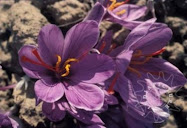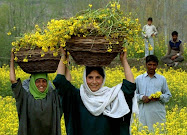 PAN DUEN is another important festival of Kashmiri Pandits celebrated since time immemorial. The festival though different of its kind enjoys tremendous reverence and popularity in all KP families wherever they’re. It’s celebrated by making a special bread cake called ROTH in Kashmiri. The wheat floor in sufficient quantity is mixed with ghee, sugar, cardamom and poppy seeds and made into dough before thick Roties are rolled and deep-fried in ghee on low heat. The quantity of the material depends mainly on the tradition of the house and the strength of the family and its extension as the Prasad has to be shared with all relatives and friends after the Pooja concludes. The auspiciousness of the occasion demands enough preparation from vigorous cleaning of the whole house especially the kitchen place to a get together of all the members of family to give the process enough sanctity. The head lady of the house takes full charge of the occasion with the juniors working under her and the work is started early in the morning after doing all washing and collecting fresh water as everything has to be done with extreme purity of hand and heart as well. The recitations of holy mantras continue throughout the process as no gossips are allowed considering the sanctity of the occasion.
PAN DUEN is another important festival of Kashmiri Pandits celebrated since time immemorial. The festival though different of its kind enjoys tremendous reverence and popularity in all KP families wherever they’re. It’s celebrated by making a special bread cake called ROTH in Kashmiri. The wheat floor in sufficient quantity is mixed with ghee, sugar, cardamom and poppy seeds and made into dough before thick Roties are rolled and deep-fried in ghee on low heat. The quantity of the material depends mainly on the tradition of the house and the strength of the family and its extension as the Prasad has to be shared with all relatives and friends after the Pooja concludes. The auspiciousness of the occasion demands enough preparation from vigorous cleaning of the whole house especially the kitchen place to a get together of all the members of family to give the process enough sanctity. The head lady of the house takes full charge of the occasion with the juniors working under her and the work is started early in the morning after doing all washing and collecting fresh water as everything has to be done with extreme purity of hand and heart as well. The recitations of holy mantras continue throughout the process as no gossips are allowed considering the sanctity of the occasion.The Mahurat (auspicious occasion) for PAN DEUN are a few dates in the bright lunar fortnight of Bhadroon around Ganesh Chuturthi festival celebrated throughout India with full gaiety and devotion. In Kashmir the festival is celebrated by the name Vinayak Chorum and the most favoured Mahurat for PAN DEUN especially if it’s a Sunday lovingly called Vinayak Choram Te Aathwaar. This year interestingly Ganesh Chaturthi was on Sunday but Chorum (4th day of the lunor fortnight) was missing in the calendar. It was the 3rd lunar day so not favoured for PAN DEUN.
Now after the recipe (PAN ROTH) is ready there is a ceremonial ritual considered very auspicious. All the prepared PAN ROTH are kept in a large wicker basket and covered with a freshly washed clean cotton cloth. A big Lota (Gadvei) of brass, now stainless-steel is filled with fresh water and after decorating it with a flower garland, Naervan (moli), sindoor, etc it is covered with a big size ROTH and a couple or more small ones and some dry fruit, shelled walnuts and some sugar candy for Prasad and kept ceremoniously on the floor while all the family members surround it with folded hands facing East. The head lady ties Naerwan and puts Tikka on the forehead of all the members and takes in her hand the cotton thread which she had been keeping on her right ear during the making of PAN ROTH. The cotton thread is mainly significant in this ritual. In olden days the cotton thread was especially twisted for the purpose out of fresh cotton wool grown in Kashmir by an unmarried young girl on the family Charkha as Goddess Durga was worshipped in her maiden form on the occasion. The thread is called PAN in Kashmiri.
All the members take in their folded hands some washed grains of rice, barley and flowers along with a little of fresh washed running grass with roots (Dramun) which grows wildly everywhere on roadsides and parks and the head lady with all sanctity relates a traditional story of a woman of yester-years called Bib Dhara Maej who used to observe the ritual with all sanctity and was very prosperous enjoying all the blessings of the Lord. Unfortunately one such day while preparing PAN ROTH with all sanctity along with her unmarried young daughter, her husband, a rich man and too conceited came in the house unexpectedly and the fit of some anger spoiled the sanctity of the ritual and left the house. Within no time the worst misfortune overcame him and the whole family. He was deprived of all his riches, name and fame till the situation reached that the family were reduced to penury. The lady couldn’t forget the episode and in most deprived conditions arranged for the ritual the next year and surprisingly their misfortune was replaced by former riches and glory once again. As the story is ceremoniously related in full the head lady opens the lid of the Lota and offers the rice and barley grains with flowes in her hand to the Lord followed by all other mambers of the family. Thus is ritual ends with everyone wishing for good heath and prosperity and the Prasad is taken.
Now the PAN NAVEED as it’s called is to be shared with all relatives and friends and the main share is given to the married daughters and sisters in the family along with the Tikka and Naerwan from the Pooja within next few days. After the displacement of Pandits from Kashmir the new found non-Kashmiri relatives, friends and neighbours eagerly wait for the PAN NAVEED for its sanctity and high taste.
.jpg)




Mr. Bhat, I don't think anyone else could have explained the sanctity of this auspicious day, the way you have. Excellent work!!!
ReplyDeleteSunil Fotedar
Faridabad
OHHH… this is really amazing..... I remember our Grandmother telling us the story sitting on jute mats with the pious perfume of freshly mopped mud floor and shimmering utensils used for the Puja.
ReplyDeleteThe comment shall be incomplete without expressing the enthusiasm of waiting for so long to have the year’s best breakfast, Sheer Chai and Roath...
DAD,
That reminds me you should write something about the traditional Sheer Chai as unfortunately this is also dying out in our so called modern nuclear families...
Thanks Rahul, your enlivening comment invigorates my sentiment to write something on Sheer-Chai which continues to be an important part of our life especially in families with elderly members particularly in Jammu.
ReplyDeleteWell exlplained. . This is exactly what is being followed.
ReplyDeleteWell exlplained. . This is exactly what is being followed.
ReplyDeleteWell explained. This is exactly what is being followed.
ReplyDeleteHi guys, this blog and the information shared here is really very helpful.. I love my gf a lot and she is kashmiri Pandit. However, I am a Jain. So I know very less about this festival. But, she stays in hostel and is missing her home and wants to do this pooja but she can't do this pooja in her hostel because of rules and several impurities there.. However, I want to conduct this pooja for her at my home. Pls help me throughout the procedure on how to do this. Please sir / madam I plead you.. Please help me
ReplyDeleteThank you so much for the story! I have enjoyed roth from your home in my childhood ...nice crisp ones ! Fond memories of visiting your house with my grandmother !
ReplyDelete🙏
ReplyDelete